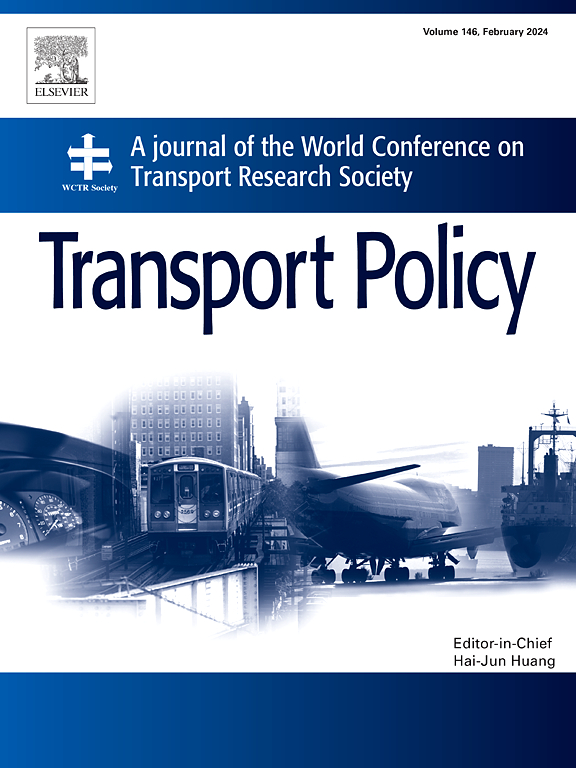Enter or not? Strategic interactions between electric vehicle manufacturers and mobility service providers
IF 6.3
2区 工程技术
Q1 ECONOMICS
引用次数: 0
Abstract
We study a vehicle manufacturer encroachment and multichannel distribution problem in which a vehicle manufacturer (VM) decides whether and how to enter the mobility service market in anticipation of its primary buyer’s responses, i.e., the existing mobility service operator (MSP). Before the VM enters, the relationship between the VM and MSP is between sellers and buyers. However, if the VM enters, their mutual relationship will be complicated. First, since the MSP is better informed than the VM about rider demand information, the VM needs to infer the true mobility service market size from the order quantity requested by the MSP, which results in a “signaling game”. Second, the VM entry might benefit or hurt the MSP, i.e., they might be substitutes or complements. Third, the VM’s entry decision influences the vehicle price. This further affects the surplus of individual buyers in the vehicle sales market and travelers in the mobility service market. In light of this, we develop a dynamic Bayesian game model to characterize the decision process of the VM and MSP. Analytical results show that when VM and MSP are “substitutes” from the perspective of end users, VM’s entry will induce the MSP to decrease its order quantity when the market size is small while maintaining the same level as in the full information setting when the market size is large. This is opposite to the outcome when they are “complements”. Moreover, the seesaw effect between the two markets normally raises MSP’s profit while reducing VM’s profit. Numerical results demonstrate that the VM can strategically determine the optimal vehicle price to induce MSP to distort the order quantity in favor of its benefits. We find that as the size of the vehicle sales market increases, the VM will be better off adopting the multichannel strategy but will allocate fewer vehicles to the mobility service market. The MSP is worse off when they are substitutes while better off when they are complements. We also find that the VM entry benefits travelers since they have additional options and the mobility service prices are lower than when the VM does not enter.
进入还是不进入?电动汽车制造商与出行服务提供商的战略互动
本文研究了一个汽车制造商入侵和多渠道分销问题,在这个问题中,汽车制造商(VM)根据其主要买家(即现有的移动服务运营商(MSP))的反应来决定是否以及如何进入移动服务市场。在虚拟机进入之前,虚拟机和MSP是卖家和买家的关系。但是,如果虚拟机进入,它们之间的关系会变得复杂。首先,由于MSP比VM更了解乘客需求信息,VM需要从MSP请求的订单数量中推断出真实的出行服务市场规模,这就形成了一个“信号博弈”。其次,VM条目可能对MSP有利或有害,也就是说,它们可能是替代品或补充。第三,虚拟机的进入决策影响了汽车价格。这进一步影响了汽车销售市场的个人购买者和出行服务市场的旅行者的过剩。鉴于此,我们建立了一个动态贝叶斯博弈模型来描述虚拟机和MSP的决策过程。分析结果表明,当VM和MSP从终端用户的角度来看是“替代品”时,VM的进入会促使MSP在市场规模较小时减少订单量,而在市场规模较大时保持与全信息设置时相同的水平。这与它们是“互补”时的结果相反。此外,两个市场之间的跷跷板效应通常会提高MSP的利润,同时降低VM的利润。数值结果表明,虚拟机可以有策略地确定最优汽车价格,以诱导MSP扭曲订购数量以有利于其利益。我们发现,随着汽车销售市场规模的增加,虚拟机采用多渠道策略将会更好,但将更少的车辆分配给移动服务市场。当它们互为替代品时,MSP的情况较差,而当它们互为互补时,MSP的情况较好。我们还发现,虚拟机的进入对旅行者有利,因为他们有更多的选择,而且出行服务价格低于虚拟机不进入时的价格。
本文章由计算机程序翻译,如有差异,请以英文原文为准。
求助全文
约1分钟内获得全文
求助全文
来源期刊

Transport Policy
Multiple-
CiteScore
12.10
自引率
10.30%
发文量
282
期刊介绍:
Transport Policy is an international journal aimed at bridging the gap between theory and practice in transport. Its subject areas reflect the concerns of policymakers in government, industry, voluntary organisations and the public at large, providing independent, original and rigorous analysis to understand how policy decisions have been taken, monitor their effects, and suggest how they may be improved. The journal treats the transport sector comprehensively, and in the context of other sectors including energy, housing, industry and planning. All modes are covered: land, sea and air; road and rail; public and private; motorised and non-motorised; passenger and freight.
 求助内容:
求助内容: 应助结果提醒方式:
应助结果提醒方式:


